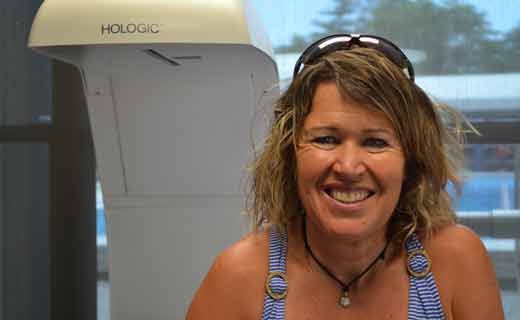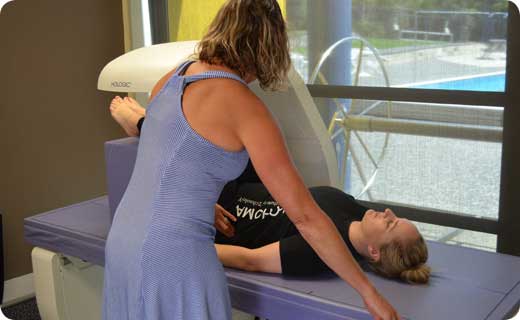Local Bone Health Study Finding Answers To Delay Osteoporosis

Wednesday, 29 Aug 2018
Preliminary results from a local Bay of Plenty study on bone health in pre-menopausal women are prompting a rethink on how people can delay the onset of osteoporosis in older age.
Toi Ohomai Institute of Technology sports lecturer and former elite marathon runner Tracey Clissold is six months into a 12-month study for her doctoral thesis. She has recruited 80 Bay of Plenty women, aged between 30-50, to test their bone health every three months.
To date, most research around bone health has focused on post-menopausal women because that’s when osteoporosis and fractures occur. Tracey wants to know how women can prevent or slow down the incidence of osteoporosis by seeing if they can build up bone density before they reach menopause.
“The studies suggest that if women can apply some force through the skeleton, like they did as kids, there is a possibility of reversing bone loss,” says Tracey. “Going into menopause with a bigger bone bank could potentially slow down the effects of osteoporosis.”
Specifically, Tracey wants to establish whether jumping exercises she has devised can stimulate the bone to keep rebuilding. During the year, half the women include two minutes of jumping into their daily routine five days a week, while the ‘control’ group continues their normal routines with no specific change.
“The preliminary data is very strong; it’s showing the women are reversing bone physiology,” says Tracey. “All the women who are jumping are gaining bone density, even those close to 50 who should be losing it; the control group is showing normal losses.”
Tracey explains that certain levels of force cause a reaction through the bone that promotes and stimulates bone building cells. But it needs to reach a minimum threshold, so if you think good ole ‘weight-bearing’ exercise is good enough for bones, think again. Walking, for example, does not provide enough force to stimulate bone development, yet that’s not what women are told, Tracey says.
“It frustrates me at how much information is out there but no one is disseminating it in such a way that people can use it and be proactive about their own health. I want to have credible research that allows me to challenge the current information.”
Tracey started her research in 2013 and spent the first few years devising the jumps, taking into account the magnitude of force through the bone on landing and other thresholds. As well, the jumps had to be simple and quick for the cohort of women to do, like vertical jumps, star jumps and jumping down from one step to another. Her point of difference was the double jump.
“One of the limitations of earlier studies is that nobody had ever done the double jump. When people jump they usually absorb the force through their body by bending their knees. I added in the reactive jump so the body stays more rigid to get the full effect of the force. They land and have to jump again immediately, like they’re jumping off a hot plate, so they don’t even think about absorbing the force.”
International interest in her work is gaining momentum. She recently had an article published in the prestigious Journal of Applied Biomechanics for her work on the jump analysis, and is hoping to present her preliminary research findings at an international conference in November.
DEXA Scanning

Tracey uses state-of-the-art DEXA (Dual Energy X-ray Absorptiometry) machine to scan the bone density and body composition of study participants. Scans are quick – just a minute or two for different bone sites and three minutes for body composition. Being part of the study and learning more about bone health has led some of the women in the control group to make lifestyle changes, which is showing up in the DEXA scans.
“Some of them are now doing more exercise and this is showing massive changes in their body composition, but their mineral density is still decreasing because they’re not doing the jumps – that’s exactly what I wanted to show.”
Up until age 30 our bodies are in a bone building phase, but after 30 both men and women start to lose bone density at 0.5-1% per year. By the end of menopause, with the added snag of oestrogen loss, women can lose up to 20-30% of their total bone density which, for thousands of New Zealand women, has led to osteoporotic fractures and potential loss of independence.
“As a nation we have 85,000 hip fractures every year and spend $1 billion dealing with the impacts of osteoporosis,” says Tracey. “More and more baby boomers are reaching older age, so the disease is going to continue having a huge impact on the health system.”
So, can women who have already reached menopause arrest mineral loss by jumping?
“I would like to think women could continue to have those gains through menopause, or at least fewer losses, but as we age there may be contraindications or reasons why some women can’t tolerate jumps.”
Tracey’s study is confined to the 30-50 year age group, but, as with most research projects, the answers found often lead to further questions, and she says there is still a lot to learn in this area. Apart from writing up her thesis, Tracey plans to design and promote a simple jumping programme that all women can incorporate into their daily routine, saying just two minutes a day could make a huge difference.
Her research will provide an original and vital contribution to preventative health care management and has the potential to reduce the direct and indirect costs of osteoporosis in New Zealand, she says.
The DEXA machine is located at the Toi Ohomai Windermere campus and is available for public consultations. Bookings for bone density and/or body composition scanning can be made at the Toi Ohomai Aquatic & Fitness Centre Reception, 07 557 8648. Clients will be referred to their GP for follow-up treatment.
